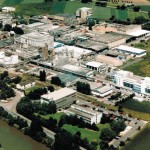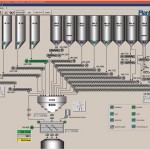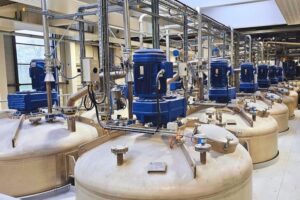At its Ladenburg production location, BK Giulini has converted the recipe- controlled process automation of its centralised mixing plant to the Plant iT V8 version. Consistently process-oriented materials management organised around a centralised module provides the basis for highly flexible mixing process sequences and enables the company to adjust rapidly to varying material specifications. In addition, the material flow acquisition ensures comprehensive batch traceability.
Guido Lohmeier
1774 is considered the year when chemistry first began to develop into a modern science. Roughly 50 years later, in 1823, the Giulini brothers founded a chemicals factory for the production of sulphuric acid. Nowadays, BK Giulini GmbH is a well-known producer of phosphate-based special products, food additives and industrial specialities. “It’s often the little details that make life enjoyable: tasty flavours, perfect dental care, a clean and hygienic household, a fresh scent and so on“, is how the company describes its product range, which is subdivided into six application-oriented business lines: phosphates and industrial specialities, products for the paper industry, water treatment and special aluminium chemical products, sanitary, food production, pharmaceutical and cosmetic products and finally parts for shoes.
In Ladenburg, one of BK Giulini‘s most important production locations, a mixing plant serves as the centralised process level for the production of phosphate-based food additives. The obsolete controller of the mixing plant urgently required modernisation, and the company took this opportunity not only to retrofit its PLC controllers but also to update its entire process control software to meet current and future requirements. The approximately 200 signals that must be captured by the automation components only play a minor role in this context: highly flexible process preparation and control are the key criteria linked to the recipe-controlled process control system.
Production changes have to be prepared in detail to prevent the use of incompatible materials. Before launching a new production series, an incompatibility check with regard to the previous production process is therefore performed automatically. Based on information stored in a database, the system suggests measures for assuring the quality of the process and the products involved. Consistent batch traceability, facilitated by the continuous logging of all material flows, is a core prerequisite for achieving utmost flexibility of each production sequence and the components involved.
High flexibility
A large number of different components, the acquisition of all material flows, the need for consistent traceability, precise batch dosing and the checks necessary to prevent material incompatibilities all amount to a very complex portfolio of process automation requirements. In view of these very specific demands, BK Giulini’s first step was to commission a conceptual study of an innovative process automation system. A comprehensive appraisal, taking into account comments and suggestions from users on process optimisation functionality, and the resulting feasibility study, incorporating a solution concept, provided the basis for implementation. In the light of this automation specification, migration from the old controller generation to a newer version was not a feasible option: the future-oriented solution now installed is based on an entirely new automation concept. At its core are the Direct iT, Batch iT and Acquis iT modules with Plant iT material, the process-oriented materials management module in the current Plant iT Version V8.
All Plant iT system modules reside in a centralised engineering environment with a shared database and a uniform user interface for parameterisation. This environment allows users to call up all system and configuration data via a tree structure similar to Windows Explorer. It provides access to user administration tools, message profiles, pools of graphic elements for visualisation, etc. and even to the complete plant structure, including individual actuators and sensors defined using cascadable geographic codes. Whole sequences within the process can be conveniently specified and programming has to a large extent been replaced by parameterisation.
This approach also permits the definition of properties relevant for storage locations, materials and transactions within the system. Materials with an identical set of properties are grouped into material classes and described precisely by setting parameters. Plant iT V8 thus offers an ideal starting point for the fully automatic entry of all consumption values in the process control system. The Plant Direct iT module forms the interface to the actuators and sensors in the process. BK Giulini’s process control system – based on the Simatic S7 PLC – integrates approximately 200 signals into the automation system.
Independent module
The Plant Batch iT module is designed as a powerful recipe and order management system that meets the specific requirements of recipe-controlled batch processes. Plant, process and recipe modelling is performed either strictly in accordance with ISA S88 or based on simplified models derived from this standard. In combination with process descriptions, processing parts lists which can also be exchanged with external systems simplify the handling of a large number of different articles.
In Plant iT Version V8, process-oriented materials management – which was previously an integral part of the Batch iT module – has been further optimised as the independent “Plant iT material” automation module located on the MES (Manufacturing Execution System) level. Based on this production and process-oriented materials management system, production management, material scheduling and quality management now also take account of technological requirements and are no longer merely focused on commercial aspects.
With Plant iT material, the storage structure of all large and small components – which are stocked at BK Giulini in one large and one small silo group on different levels in the production building – is organised extremely precisely down to the individual packages. Each Plant iT V8 module communicates independently with the higher-level “Plant iT material” materials management module and posts entries there. This module thus unites the entire functionality of storage management, stock control, batch tracking and statistical analyses and provides consistent material feed rates for the mixing process. The Plant iT V8 process control system links the process level to the materials management system in real time. Plant iT material is therefore the perfect tool for:
- Material and batch tracking
- Sequence and resource monitoring
- Quality assurance
- Process optimisation
Based on master data, all storage locations, storage transactions and materials are captured with the utmost precision and all material movements and transactions recorded in the database practically in real time. This not only includes all data created automatically for large components and finished products by the recipe controller, the process control system, the incoming goods system and the dispatch and storage systems but also the data for all manually fed small components – from incoming goods all the way through the process up to goods issue. To make this sequence as simple and safe as possible for production, BK Giulini has equipped its manual feeding stations with WLAN manual scanners. All consumption values can be precisely assigned to a specific product and batch. Finally, the necessary flexibility with regard to material selection and mixing process control in no way compromises quality assurance, because precise batch tracing ensures the highest quality levels. The Plant iT V8 process control system resides on a consistent, open and non-proprietary data, information and communication structure that extends from the process level (including sensors, valves, motors and actuators) through the MES level (such as production and machine data acquisition, the control centre and the plant controller) to the higher-level ERP (Enterprise Resource Planning) system.
Online-Info www.cpp-net.com/2309435
Share:








